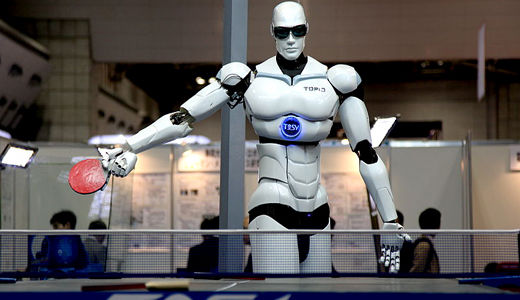
During a time when workers face the threat of outsourcing and even slave labor, it was a point of interest for Marshall Brain, author of Robotic Nation, to examine a situation in which robots are claiming a sizable chunk of growing industries in the world. Brain is also the founder of How Stuff Works, a website that examines how social, cultural, and scientific things function.
Brain told MSNBC that by 2013, there will be 1.2 million industrial robots working throughout the world, and even now, robots are doing everything from analyzing documents to filling prescriptions.
The University of California, San Francisco Medical Center recently launched a completely robotics-controlled pharmacy at two of its hospitals. The robots pick, package, and dispense doses of pills. Jon Roth, CEO of the California Pharmacists Association, responding to the introduction of prescription vending machines in some California clinics, said removing pharmacists from the process “could at best result in suboptimal therapy and at worst result in dangerous therapy.”
Meanwhile, journalists may want to mark computers as coming contenders, because a startup called Narrative Science has software to actually create machine-generated stories, especially for covering baseball and softball events. After a game, scorekeepers email game data that is then processed and arranged into a cohesive story within minutes. What implications this will have for experienced, creative sports writers remains to be seen.
Robots have long been a feature in factory work.
Recently, controversial technology giant Foxconn announced it would replace its workers in China with a million robots in three years to cut rising labor expenses. Tasks the robots will perform include spraying, welding, and assembling in factories.
Foxconn is the worlds largest maker of electronic components and also the largest private employer in China. It supplies all the big name companies including Apple Inc., Nintendo, Nokia, and Amazon.com. But allegations of bad practices include not only price fixing, but also harmful and dangerous working conditions, even resulting in worker suicides.
What happens when a robot takes a job away from a living person?
According to Martin Ford, a contributor to The Fiscal Times and author of The Lights in the Tunnel: Automation, Accelerating Technology, and the Economy of the Future, machines are doing little to solve the massive jobs crisis in the U.S. today.
A growing problem, he said in a recent blog post, is that, “At some point, we’re going to get to where machines stop being tools for workers and become workers in their own right. Without an income, people can’t participate in the economy. The current situation we’re in could really drag on and while we’re waiting for the job market to recover, these technologies are going to continue to accelerate, and it’ll be more difficult to get [our] jobs back. It will be like running up an escalator that’s going down.”
And yet, on the other side of the picture, there are many positives to new technological developments, many of which have helped people in recent times.
In 2007, a steam conduit exploded beneath a New York City street, killing one person and injuring many others. Officials said that steam mains underground were not inspected on a regular basis because doing so often means digging up the street. However, robotic probes could detect corrosion or damage to steam pipes without having to dig up the ground.
Furthermore, said a report from Microsoft’s research blog, robots are extremely beneficial in search-and-rescue missions, or in disaster situations. They can explore areas that are too dangerous for humans to be in – one important and obvious example being the nuclear power plant disaster in Japan,where robots were sent into damaged plants to test radiation levels, and to remove rubble in disaster areas after the tsunami.
Sherry Turkle, a professor at the Massachusetts Institute of Technology, has written several books and studies the impact of technology, particularly robotics, on society. She told The Chronicle of Higher Education that she felt concerned that robots were increasingly taking roles in lines of work that she believed only humans should fill.
For Turkle, it all comes down to a simple concern that we, in allowing technology and robots greater control, are regressing as humans.
“We talk about spending hours on email, but we, too, are being spent,” Turkle concluded. “We have invented inspiring and enhancing technology, and yet we have allowed it to diminish us.”
Photo: A humanoid robot named TOPIO, playing ping-pong at the 2009 Tokyo International Robot Exhibition. Humanrobo/Wikipedia












Comments